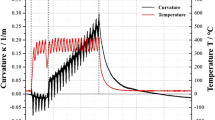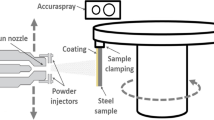Abstract
Plasma sprayed coatings of Yttria Stabilized Zirconia (YSZ) have been studied extensively through the years to understand variations in coating properties as well as to achieve control on microstructure of the coatings. The requirement for microstructural control and reliability have become all the more important as coatings have now become part of an integrated “prime reliant” design strategy aimed at increasing turbine inlet temperature and associated efficiencies. One of the important thrusts in monitoring and controlling the process has been the application of process sensors that measure spray stream characteristics, notably particle temperature and velocity. Although single particle-based measurements have been available for some time, in general control strategies based on particle state rely on average values of temperature and velocity. In this study, a detailed examination of particle temperature distributions is presented. When systematically examined over a wide range of operating conditions of the resulting range of particle temperatures, a significant structure in the statistical distribution has been observed. A close inspection of the data indicates that this distribution can be interpreted as melting state indicator for YSZ. A characteristic peak at the melting point of ZrO2 (error in absolute T-measurement is ≈ ±10%) can be used as an indicator for re-solidified particles. In the past, control strategies based on process diagnostic sensors have been based on average particle temperatures and velocities. Although the average values seem to be promising as control parameters, it has been shown through our results that different melting states could be demonstrated for the same average T and V settings. The melting state in turn has an important bearing on the coating structure and properties. It therefore implies that a process control strategy (to maintain coating quality) based on in flight particle sensors will have to take these findings into account. As an example, one strategy of process control would not only define the process in terms of the average particle temperature and velocity but also include the effect that parameter changes have on distributions.
Similar content being viewed by others
References
C. Moreau, M. Lamontagne, and P. Cielo, Method and apparatus for monitoring the temperature and velocity of plasma sprayed particles, US Patent 5,180,921.
C. Moreau, P. Gougeon, M. Lamontagne, V. Lacasse, G. Vaudreuil, and P. Cielo, On-line control of the plasma spraying process by monitoring the temperature, velocity and trajectory of in-flight particles, in 7th National Thermal Spray Conference, (S. Sampath and C. C. Berndt, eds.), ASM International, Boston, Massachusetts, 1994, pp. 431–438.
M. L. Yeoman, B. J. Azzopardi, H. J. White, C. J. Bates, and P. J. Roberts, Optical development and application of a two colour LDA system for the simultaneous measurement of particle size and particle velocity, in Engineering Applications of Laser Velocimetry, American Society of Mechanical Engineers, Phoenix, AZ, 1982, pp. 127–135.
T. Streibl, K, D. Landes, and G. Forster, PSI: New diagnostics for the determination of particle size and shape in thermal spray processes, in 1st International Thermal Spray Conference, (C. C. Berndt, ed.), ASM International, Motreal, Quebec, Canada, 2000, p. 67.
S. Zimmermann K. Landes (2004) Microstruct. Process. 383 153
J. R. Fincke D. C. Haggard W. D. Swank (2001) J. Thermal Spray Technol. 10 255
J. R. Fincke W. D. Swank R. L. Bewley D. C. Haggard M. Gevelber D. Wroblewski (2001) Surf. Coat. Technol. 146 537 Occurrence Handle10.1016/S0257-8972(01)01432-3
W. D. Swank, J. R. Fincke, and D. C. Haggard, A Particle temperature sensor for monitoring and control of the thermal spray process, in Thermal Spray Science and Technology: Proceedings of the 8th National Thermal Spray Conference, ASM International, Houston, Texas, US, 1995.
J. Vattulainen E. Hamalainen R. Hemberg P. Vuoristo T. Mantyla (2001) J. Thermal Spray Technol. 10 94
J. F. Bisson, M. Lamontagne, C. Moreau, L. Pouliot, J. Blain, and F. Nadeau, Ensemble in-flight particle diagnostics under thermal spray conditions, in Thermal Spray 2001: New Surfaces for a New Millennium, ASM International, Singapore, 2001.
G. Bourque M. Lamontagne C. Moreau (2000) A new sensor for on-line monitoring the temperature and velocity of thermal spray particles C. C. Berndt (Eds) 1st International Thermal Spray Conference ASM International Montreal, Quebec, Canada 45
J. Zierhut K. D. Landes (2000) Particle flux imaging (PFI) in-situ diagnostics for thermal coating processes C. C. Berndt (Eds) 1st International Thermal Spray Conference ASM International Montreal, Quebec, Canada 63
H. Zhang, H. B. Xiong, L. L. Zheng, A. Vaidya, L. Li, and S. Sampath, Melting behavior of in-flight particles and its effects on splat morphology in plasma spraying, in International Mechanical Engineering Congress and Exposition, ASME International, New Orleans, Louisiana, USA, 2002, pp. 1–8.
G. Wei, H. Xiong, L. Zheng, and H. Zhang, Modeling from particle in-flight to coating build-up for thermal spray processes, in ASME Heat Transfer/Fluids Engineering Summer Conference, ASME, Charlotte, North Carolina, USA, 2004.
P. Fauchais M. Vardelle A. Vardelle L. Bianchi A. C. Leger (1996) Plasma Chem. Plasma Process. 16 S99
P. Fauchais M. Vardelle A. Vardelle L. Bianchi (1996) Ceram. Int. 22 295 Occurrence Handle10.1016/0272-8842(95)00106-9
M. Friis C. Persson J. Wigren (2001) Sur. Coat. Technol. 141 115
M. Prystay P. Gougeon C. Moreau (2001) J. Thermal Spray Technol. 10 67
R. Mcpherson (1989) Surf. Coat. Technol. 39/40 173 Occurrence Handle10.1016/0257-8972(89)90052-2
P. Bengtsson T. Johannesson J. Wigren (1995) J. Thermal Spray Technol. 4 IssueID3 245
M. Vardelle A. Vardelle P. Fauchais C. Moreau (1994) Meas. Sci. Technol. 5 205 Occurrence Handle10.1088/0957-0233/5/3/002 Occurrence Handle1994MeScT...5..205V
M. Vardelle A. Vardelle A. C. Leger P. Fauchais D. Gobin (1995) J. Thermal Spray Technol. 4 50
D. Gilmore R. Neiser Y. Wan S. Sampath (2000) Process maps for plasma spray Part I: Plasma–particle interactions C. C. Berndt (Eds) Thermal Spray Surface Engineering via Applied Research (Proceedings of the 1st ITSC, May 2000) ASM International Materials Park 149–155
X. Jiang, J. Matejicek, A. Kulkarni, H. Herman, S. Sampath, D. Gilmore, and R. Neiser, Process maps for plasma spray Part II: Deposition and properties, in Thermal Spray Surface Engineering via Applied Research (Proceedings of the 1st ITSC, May 2000), (C. C. Berndt, ed.), ASM International, Materials Park, 2000, pp. 157–163.
S. Sampath X. Jiang A. Kulkarni J. Matejicek D. L. Gilmore R. A. Neiser (2003) Mater. Sci. Eng. A 348 54
S. Sampath X. Y. Jiang J. Matejicek L. Prchlik A. Kulkarni A. Vaidya (2004) Mater. Sci. Eng. A 364 216
A. Vaidya, T. Streibl, L. Li, S. Sampath, A. Gouldstone, O. Kovarik, and R. Greenlaw, Comprehensive study of the process–property correlations: Case study for molybdenum coatings, in ITSC 2004, Thermal Spray Solutions: Advances in Technology and Application, Electronic Publication, Osaka, Japan, 2004.
M. Vardelle A. Vardelle A. C. Leger P. Fauchais (1994) Dynamics of splat formation and solidification in thermal spraying process C. C. Berndt S. Sampath (Eds) Thermal Spray Industrial Applications ASM International Materials Park, OH, USA, Boston, MA 555–562
S. Fantassi M. Vardelle A. Vardelle P. Fauchais (1993) J. Thermal Spray Technol. 2 379
L. Bianchi F. Blein P. Lucchese M. Vardelle A. Vardelle P. Fauchais (1994) Effect of particle velocity and substrate temperature on alumina and zirconia splat formation C. C. Berndt S. Sampath (Eds) Thermal Spray Industrial Applications ASM International Materials Park, OH, USA, Boston, MA 569–574
J. Madejski (1976) Int. J. Heat Mass Transfer. 19 1009 Occurrence Handle1976IJHMT..19.1009M Occurrence Handle0328.76070
Y. P. Wan H. Zhang X. Y. Jiang S. Sampath V. Prasad (2001) J. Heat Transfer-Trans. ASME 123 382
H. Zhang (1999) Int. J. Heat Mass Transfer. 42 2499 Occurrence Handle0984.76091
A. Vaidya, G. Bancke, S. Sampath, and H. Herman, Influence of process variables on the plasma sprayed coatings: An integrated study, in International Thermal Spray Conference (ITSC), (B. C. C. and K. K. A., eds.), ASM International, Materials Park, OH, Singapore, 2001, pp. 1345–1349.
M. Friis P. Nylen C. Persson J. Wigren (2001) J. Themal Spray Technol. 10 301
M. Friis P. Nylén (2003) A numerical study of the sources of variation in particle in-flight characteristics in atmospheric plasma spraying C. C. Berndt (Eds) Thermal Spray 2003: Recognizing the Past, Supporting the Future and Nurturing Prosperity ASM International Materials Park, OH, USA, Orlando, FL
S. Guessasma G. Montavon C. Coddet (2005) Surf. Coat. Technol. 192 70 Occurrence Handle10.1016/j.surfcoat.2004.03.020
D. Scott (1979) Biometrika 66 605 Occurrence Handle0417.62031 Occurrence Handle81c:62006
D. Ng, Two-step calibration of a multiwavelength pyrometer for high temperature measurement using a quartz lamp, NASA/TM-2001-211124, Glenn Research Center, Cleveland, Ohio, 2001.
D. Ng G. Fralick (2001) Rev. Sci. Instrum. 72 1522 Occurrence Handle10.1063/1.1340558 Occurrence Handle2001RScI...72.1522N
V. A. Petrov A. P. Chernyshev (1999) High Temp. 37 58
L. A. Dombrovsky (2002) J. Quant. Spectrosc. Radiative Transfer. 73 433 Occurrence Handle2002JQSRT..73..433D
M. Friis C. Persson (2003) J. Thermal Spray Technol. 12 44
J. F. Bisson C. Moreau (2003) J. Thermal Spray Technol. 12 258
J. F. Bisson B. Gauthier C. Moreau (2003) J. Thermal Spray Technol. 12 38
P. Fauchais (2004) J. Phys. D: Appl. Phys. 37 86 Occurrence Handle10.1088/0022-3727/37/9/R02 Occurrence Handle2004JPhD...37R..86F
Author information
Authors and Affiliations
Corresponding author
Rights and permissions
About this article
Cite this article
Streibl, T., Vaidya, A., Friis, M. et al. A Critical Assessment of Particle Temperature Distributions During Plasma Spraying: Experimental Results for YSZ. Plasma Chem Plasma Process 26, 73–102 (2006). https://doi.org/10.1007/s11090-005-8727-2
Received:
Revised:
Issue Date:
DOI: https://doi.org/10.1007/s11090-005-8727-2




